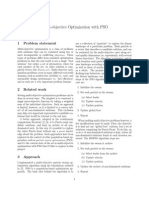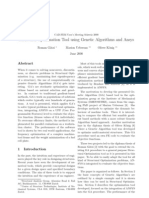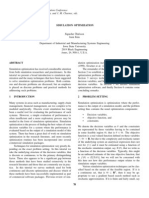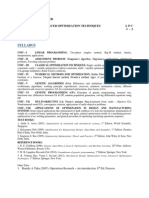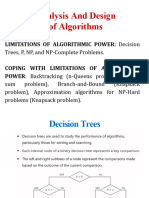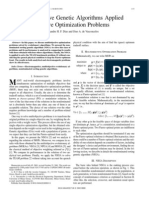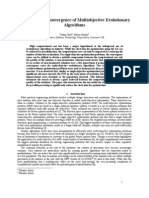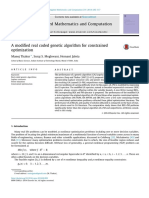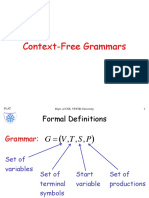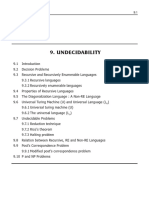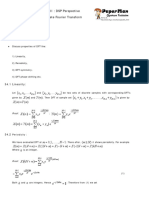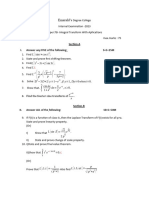Non Dominated Sort
Non Dominated Sort
Uploaded by
pratikresourceCopyright:
Available Formats
Non Dominated Sort
Non Dominated Sort
Uploaded by
pratikresourceCopyright
Available Formats
Share this document
Did you find this document useful?
Is this content inappropriate?
Copyright:
Available Formats
Non Dominated Sort
Non Dominated Sort
Uploaded by
pratikresourceCopyright:
Available Formats
An Efcient Non-dominated Sorting Method
for Evolutionary Algorithms
Hongbing Fang
hfang@uncc.edu
Department of Mechanical Engineering and Engineering Science, University of North
Carolina at Charlotte, Charlotte, NC 28223, USA
Qian Wang
qwang2@engineering.uiowa.edu
Kal Krishnan Consulting Services, Inc., 300 Lakeside Drive # 1080, Oakland, CA 94612
Yi-Cheng Tu
tuyc@cs.purdue.edu
Department of Computer Science, Purdue University, West Lafayette, IN 47907, USA
Mark F. Horstemeyer
mfhorst@me.msstate.edu
Department of Mechanical Engineering, Mississippi State University, Starkville,
MS 39762, USA
Abstract
We present a new non-dominated sorting algorithm to generate the non-dominated
fronts in multi-objective optimization with evolutionary algorithms, particularly the
NSGA-II. The non-dominated sorting algorithm used by NSGA-II has a time com-
plexity of O(MN
2
) in generating non-dominated fronts in one generation (iteration)
for a population size N and M objective functions. Since generating non-dominated
fronts takes the majority of total computational time (excluding the cost of tness
evaluations) of NSGA-II, making this algorithm faster will signicantly improve the
overall efciency of NSGA-II and other genetic algorithms using non-dominated sort-
ing. The new non-dominated sorting algorithm proposed in this study reduces the
number of redundant comparisons existing in the algorithm of NSGA-II by recording
the dominance information among solutions from their rst comparisons. By utilizing
a new data structure called the dominance tree and the divide-and-conquer mech-
anism, the new algorithm is faster than NSGA-II for different numbers of objective
functions. Although the number of solution comparisons by the proposed algorithm
is close to that of NSGA-II when the number of objectives becomes large, the total
computational time shows that the proposed algorithm still has better efciency be-
cause of the adoption of the dominance tree structure and the divide-and-conquer
mechanism.
Keywords
Genetic algorithm, evolutionaryalgorithm, non-dominatedsorting, divide-and-conquer,
dominance tree.
1 Introduction
Design optimization for many engineering applications is multi-objective in nature.
For most multi-objective problems, the objectives conict with each other, and it is
impossible to obtain a single set of values for the design variables that corresponds to
C
2008 by the Massachusetts Institute of Technology Evolutionary Computation 16(3): 355384
H. Fang, Q. Wang, Y. Tu, and M. F. Horstemeyer
the optima of all the objectives. In this situation, an optimal solution represents a certain
level of trade-offs among all of the objectives, and a set of trade-off solutions exists for
a multi-objective optimization problem. The set containing all the trade-off solutions is
formally called the Pareto front (Coello, 1999), and the solutions on the Pareto front are
also called non-dominated solutions. Therefore, solving a multi-objective optimization
problem refers to obtaining a subset of the solutions on the Pareto front instead of
getting each objectives optimum.
If the relative importance of all the objectives is known, we can assign a weight
coefcient to each objective, combine all the weighted objective functions into a sin-
gle objective, and solve it as a single-objective problem. Alternatively, if we know the
limits of all but one objective, we can change those objectives with known limits into
constraints and nd the optimum of the objective with no limit. In both cases, the
multi-objective optimization problem can be solved using single-objective optimiza-
tion methods. However, selecting the weight coefcients for each objective and/or
determining the objective limits are largely based on the designers preferences and
experiences. The single solution thus obtained may not be satisfactory. It is desirable to
obtain a set of solutions with different levels of trade-offs from which the designers can
select the nal design(s).
Although we can obtain multiple trade-off solutions by using different combina-
tions of the weight coefcients in the aforementioned single-objective approach, solu-
tions can be lost on the concave region of the solution space (Das and Dennis, 1997). To
this end, the genetic algorithm, which was rst introduced by Holland (1975) belonging
to the family of evolutionary algorithms, has been used to obtain solutions with good
spread on the Pareto front even when the solution spaces contain concave regions. Over
the past ten years, there has been an increasing interest in solving multi-objective opti-
mization problems using evolutionary algorithms such as NSGA-II (Deb et al., 2002a),
PESA (Corne et al., 2000), PAES (Knowles and Corne, 2000), SPEA (Zitzler and Thiele,
1999), and Micro-GA (Coello and Pulido, 2001).
The non-dominated sorting genetic algorithm (NSGA) developed by Srinivas and
Deb (1995) has been reported to converge to the Pareto front with a good spread of
solutions. However, NSGA was also criticized for its lack of elitism and high com-
putational cost, a time complexity of O(MN
2
) for M objectives and N solutions. This
time complexity is determined by the non-dominated sorting algorithm for generating
the non-dominated fronts in each generation; therefore, improving the computational
efciency of non-dominated sorting will improve the overall efciency (the cost for
tness evaluation is excluded). The NSGA-II was subsequently developed to reduce
the computational cost as well as to include elitism (Deb et al., 2002a). We refer to the
non-dominated sorting algorithm of NSGA-II as Debs algorithm hereafter in this pa-
per. Although Debs algorithm adopts a better bookkeeping scheme and is faster than
NSGA, its time complexity remains the same as that of NSGA. The computational cost
of NSGA-II is still high due to the repetitive comparisons between the same pairs of
solutions when generating the non-dominated fronts.
Jensen proposed a non-dominated sorting algorithm to improve the computa-
tional efciency of NSGA-II and other evolutionary algorithms that perform non-
dominated sorting (Jensen, 2003). He showed that the time complexity of his algorithm
is O(MN log
M1
N). However, Jensens algorithm does not generate the same non-
dominated fronts as those generated by Debs algorithmwhen there are duplicate solu-
tions inthe population. Jensens algorithmputs duplicatedsolutions into the same front;
this is not desirable for evolutionary algorithms. We compared the processing times of
356 Evolutionary Computation Volume 16, Number 3
Efcient Non-dominant Sorting Method
Jensens algorithm with that of Debs algorithm and found different speedups from
those reported by Jensen (2003).
In this paper, we present a new non-dominated sorting algorithm that generates
the same non-dominated fronts as Debs algorithm. The new algorithm adopts the
divide-and-conquer mechanism as well as a data structure called dominance tree to
improve both computational and memory efciencies of NSGA-II. This new algorithm
was found to preserve satisfactory speedups when the number of objectives becomes
large, which was not true for Jensens algorithm. In the remaining portion of this paper,
we give an overview of Debs and Jensens algorithms. Then we present details of the
dominance tree and the divide-and-conquer mechanism used in our new algorithm.
Finally, we compare the performance of the new algorithm with those of Debs and
Jensens algorithms on the number of operations and processing time; this is followed
by some concluding remarks.
2 Overview of Non-dominated Sorting Algorithms
For multi-objective optimization problems solved by genetic algorithms, an initial set
of solutions called a population is randomly generated. A set of genetic operators,
selection, crossover, and mutation, are then applied to the solutions to generate a new
set of solutions for the next iteration called a generation. The nal set of solutions
is obtained after a certain number of generations. After performing the Pareto non-
dominance check, the nal solutions are all non-dominated or trade-off solutions such
that no solution is strictly better than any other solutions in the set. We now provide
some denitions that will be used in the following discussions.
We dene that Solution x dominates Solution y in a minimization problem of m
objectives by
x y |
i
: f
i
(x) f
i
(y) and
j
: f
j
(x) < f
j
(y) (1)
where f
i
(x) andf
i
(y) are the values of the i-th objective corresponding to x and y, re-
spectively. The above denition means that all the objectives corresponding to Solution
x are smaller than or equal to those corresponding to y, and there exists at least one
objective whose value for x is smaller than that for y. If x does not dominate y and vice
versa, the two are said to be non-dominated. A set of non-dominated solutions is called
a non-dominated front.
For solutions of a given population, there may be multiple non-dominated fronts.
We assign each front a unique number and represent it by Front
k
, where k (k > 1) is the
front number. In this study, we rank all the fronts by their front numbers with smaller
numbers representing higher ranks. For example, Front
1
ranks higher than Front
2
and
Front
3
. The non-dominated fronts have the following properties.
1. A solution in Front
k+1
must be dominated by at least one solution in Front
k
.
2. A solution in Front
k+1
may or may not dominate solutions in Front
k+2
.
Solutions in a higher-ranked front have higher preference (tness) in the selection
process than those in a lower-ranked front, because the latter is dominated by the
former. We now introduce NSGA-II and briey discuss Jensens sorting algorithm.
Evolutionary Computation Volume 16, Number 3 357
H. Fang, Q. Wang, Y. Tu, and M. F. Horstemeyer
Rejected
New population
Non-dominated
Sorting
Fronts
1
2
3
4
5
6
Rejected
Crowding Distance
Sorting
P
a
r
e
n
t
C
h
i
l
d
Figure 1: Schematic procedure of NSGA-II.
2.1 The Non-dominated Sorting Algorithm of NSGA-II
In each generation in NSGA-II, genetic operators are applied to the parent population to
obtain an equal sized child population. The parent and child are then combined to form
a temporary population on which the non-dominated sorting algorithm is applied to
generate the non-dominated fronts. Therefore, the population size for non-dominated
sorting is twice as large as the parent population.
The populationfor the next generationhas the same size as the parent population; its
solutions are selected from non-dominated fronts with the highest ranks. The solutions
within a front are sorted by crowding-distances so that those with the largest crowding-
distances are selected into the next generation, if only a portion of the front can be
selected. Details about the denitionandsortingalgorithmof crowding-distance sorting
can be found in the literature (Deb et al., 2002a). Figure 1 illustrates the schematic
procedure of NSGA-II in one generation.
In NSGA-II, non-dominated fronts are obtained one after another starting from the
one with the highest rank to the one with the lowest rank. The procedure for generating
the rst front of a population of N solutions is as follows.
1. Create a population P by combining the parent and offspring populations.
2. Create an empty front F. Remove the rst solution s
1
from P and put s
1
into F.
3. Compare the second solution s
2
in P with s
1
. If s
1
dominates s
2
, s
2
remains in P and
go to next step; otherwise, remove s
2
fromP and put it into F. If s
1
is dominated by
s
2
, remove s
1
from F and put it back to P; otherwise, s
1
and s
2
are non-dominated.
4. Compare s
i
(i = 3, 4, . . . , N) in P with all solutions in F. If solution s
i
is dominated
by a solution inF, s
i
remains in P. Any solutions inF dominatedby s
i
are removed
from F and put back to P. If s
i
is not dominated after all the comparisons, s
i
is
removed from P and put into F.
After all the comparisons in the above procedure are nished, the solutions in F
form the rst non-dominated front.
Solutions remaining in P are used to generate the second and subsequent fronts
with the same procedure as that for the rst front. The number of solution comparisons
358 Evolutionary Computation Volume 16, Number 3
Efcient Non-dominant Sorting Method
Table 1: Objective Values of a Population of Eight Solutions
Solution f
1
f
2
f
3
1 182.08 100.13 192.21
2 187.53 246.16 203.20
3 197.15 201.57 318.86
4 47.48 74.96 22.69
5 37.05 304.83 381.19
6 126.88 54.58 144.17
7 101.77 49.18 111.91
8 37.47 18.63 446.57
Figure 2: The dominance array and non-dominated fronts of eight solutions. (a) The
dominance array; (b) the non-dominated fronts.
in the above procedure is in the order of O(N
2
). For an optimization problem with
M objectives, we need M comparisons in the worst case to determine the dominance
between any two solutions. The time complexity of the above procedure is therefore
O(MN
2
) (Deb et al., 2002a).
We now demonstrate the non-dominated sorting algorithm of NSGA-II with the
following example to identify where the inefciency comes from. This example will
also be used in Section 3 to demonstrate the newnon-dominated sorting algorithm. The
objective values of the eight solutions were randomly generated (Table 1).
The dominance relationship between any two solutions can be represented with a
matrix as shown in Figure 2(a). For an element A
ij
in the dominance matrix, a value
of 1 means that Solution i dominates Solution j, 1 means that Solution j dominates
Solution i, and 0 means that the two solutions are non-dominated. Note that only the
upper triangle is needed to keep all the pair relationships. Figure 2(b) shows the nal
non-dominated fronts for the example population of the eight solutions.
Following the aforementioned procedure, we generated the non-dominated fronts
of Figure 2(b) with detailed steps given in Table 2. A total of 18 paired comparisons are
needed including some repetitive comparisons between Solutions 1 and 2 and Solutions
1 and 3. Solutions 1 and 2 are compared three times and the same is true for Solutions
1 and 3.
Evolutionary Computation Volume 16, Number 3 359
H. Fang, Q. Wang, Y. Tu, and M. F. Horstemeyer
Table 2: An Example of the Non-dominated Sorting Algorithm in NSGA-II
Front No. Step Solution(s) in front Remaining solution(s) Comparison
0 1, 2, 3, 4, 5, 6, 7, 8
1 1 2, 3, 4, 5, 6, 7, 8
2 1 2
, 3, 4, 5, 6, 7, 8 1 & 2
3 1 2
, 3
, 4, 5, 6, 7, 8 1 & 3
1 4 4 1
, 2
, 3
, 4, 5, 6, 7, 8 1 & 4
5 4, 5 1
, 2
, 3
, 6, 7, 8 4 & 5
6 4, 5, 6 1
, 2
, 3
, 7, 8 4 & 6, 5 & 6
7 4, 5, 7 1
, 2
, 3
, 6
, 8 4 & 7, 5 & 7, 6 & 7
8 4, 5, 7, 8 1
, 2
, 3
, 6
4 & 8, 5 & 8, 7 & 8
0 1, 2, 3, 6
1 1 2, 3, 6
2 2 1 2
, 3, 6 1 & 2
3 1 2
, 3
, 6 1 & 3
4 6 1
, 2
, 3
1 & 6
0 1, 2, 3
3 1 1 2, 3
2 1 2
, 3 1 & 2
3 1 2
, 3
1 & 3
0 2, 3
4 1 2 3
2 2, 3 2 & 3
Total number of solution comparisons 18
Solution found dominated
If the dominance information between Solutions 1 and 2 can be saved after their
rst comparison, we can reduce the number of repetitive comparisons. The same is true
for the case of Solutions 1 and 3. Before we present the new algorithm of this paper, we
briey introduce Jensens algorithm and compare it with that of NSGA-II.
2.2 Jensens Non-dominated Sorting Algorithm
Jensens algorithm was an extension to the algorithm developed by Kung et al. (1975),
which only found the rst non-dominated fronts. In Jensens algorithm, the solutions
are rst sorted by the objective values before the non-dominated fronts are generated.
For the case of two objectives, a straightforward approach is taken by sorting all the
solutions by their values of the rst objective and then comparing their second objective
values to determine their fronts. For the cases of three or more objectives, a divide-and-
conquer mechanism is adopted such that the solutions are recursively divided into
smaller subpopulations and comparisons are recursively performed based on each of
the objectives. Details of Jensens algorithm can be found in Jensen (2003), and the
source code of this algorithm, implemented in C++, can be freely downloaded from
the Web site (Jensen, 2008).
If duplicate solutions exist in a population, the same duplicates will be sorted into
the same fronts by Jensens algorithm, while only one of the duplicate solutions enters
a front by Debs algorithm. To demonstrate this, we used the DTLZ1 benchmark (Deb
et al., 2002b) to obtain the objective values for seven randomly generated populations
corresponding to two to eight objectives, respectively. All the populations had a size
360 Evolutionary Computation Volume 16, Number 3
Efcient Non-dominant Sorting Method
Table 3: Sizes of Non-dominated Fronts Generated by Jensens and Debs Algorithms
Number of objectives
2 3 5 8
Front no. Jensens Debs Jensens Debs Jensens Debs Jensens Debs
1 13 13 25 25 81 79 117 115
2 22 21 34 33 76 75 65 63
3 12 11 43 40 33 35 17 20
4 16 16 44 43 9 10 1 2
5 18 17 32 32 1 1
6 20 18 17 16
7 19 19 3 9
8 25 23 2 2
9 18 21
10 13 15
11 10 10
12 8 9
13 4 3
14 2 3
15 1
of 200; they were then used to generate the non-dominated fronts by Jensens and Debs
algorithms. Table 3 shows the results for two, three, ve, and eight objectives.
The results showed that Jensens algorithms did not generate the same non-
dominated fronts as Debs algorithm due to the aforementioned reason. Correcting
this deciency of Jensens algorithm is non-trivial, because the comparisons between
two solutions were made for each objective and the duplicates can be identied only
after sorting based on all the objectives. Since this is not the focus of this study, it is not
addressed in this paper. We also compared the processing times of Jensens algorithm
with those of Debs algorithmand the newalgorithmproposed in this paper; the results
will be presented in Section 4.
3 The New Non-dominated Sorting Algorithm
We found from the example in Section 2.1 that Debs algorithm did not save the domi-
nance information among solutions from their rst comparisons. As a result, repetitive
comparisons may occur between the same pair of solutions and thus increase the com-
putational time.
The basic idea of the proposed non-dominated sorting algorithmis that, if the dom-
inance information from the rst comparisons can be saved for any two solutions, we
can then eliminate the redundant comparisons between the same pairs of solutions.
Furthermore, we do not even need to compare all the pairs of solutions. For example, if
SolutionAis foundto dominate SolutionB, all solutions already foundbeing dominated
by Solution B do not need to compare with Solution A, because they are all dominated
by Solution A. Because the dominance information among solutions is hierarchical, a
hierarchical data structure, that is, a tree structure, is preferred to save the dominance
information. In this study, we used the dominance tree presented in Section 3.1 for this
purpose. We also adopted the divide-and-conquer mechanism to make the new algo-
rithm faster and more efcient in obtaining the dominance information. The idea will
Evolutionary Computation Volume 16, Number 3 361
H. Fang, Q. Wang, Y. Tu, and M. F. Horstemeyer
1
4
6
5
Root
7 8
2 3
Figure 3: A dominance tree of eight solutions. A single-line connects nodes containing
non-dominated solutions, and a double-line connects solutions with dominance.
become clear in the discussion in Section 3.2 when we demonstrate the new algorithm
using the example of Section 2.1.
3.1 The Dominance Tree
We developed a data structure called the dominance tree to save the dominance infor-
mation among solutions in order to reduce the number of repetitive comparisons. The
basic unit of a dominance tree is called a node, which keeps a solution and is linked to
other nodes. There are two types of links between any two nodes, the non-dominance
link and the dominance link. The nodes connected with a non-dominance link are called
siblings whose solutions are non-dominated. The nodes connected with a dominance
link are called parent and child, respectively, with the solution in the parent node
dominating the one in the child node. The dominance tree for the example problem in
Section 2 is shown in Figure 3, in which 4, 5, 7, and 8 are sibling nodes and Node 4
(parent) dominates Node 1 (child). If several sibling nodes are dominated by the same
parent node, only one dominance link is needed between the parent node and the rst
sibling node. This is the case for Nodes 1, 2, and 3 in Figure 3.
Similar to the rules for non-dominated fronts given in Section 2, the solution of a
child node in a dominance tree cannot dominate any of its parents siblings. On the
other hand, the solution of a node may not necessarily dominate its siblings children.
For example, Node 1 in Figure 3 cannot dominate Nodes 5, 7, or 8, which are the siblings
of the parent of Node 1. On the other hand, Nodes 5, 7, and 8 may or may not dominate
Node 1. In fact, Node 1 is dominated by Node 7 but is non-dominated with Nodes 5
and 8.
After the dominance tree is generated for the entire population, we can obtain the
non-dominated fronts by merging the children of all siblings at the same levels. This
process starts from the root of the dominance tree and propagates until no more merge
needs to be performed. For example, to obtain the non-dominated fronts in Figure 2(b)
from the dominance tree in Figure 3, we start by merging Nodes 1 and 6; this results
in Node 6 dominating Node 1. In this example, only one merge is needed to form the
non-dominated fronts.
The algorithm for merging the children of siblings is the same as that for merging
two dominance trees; this will be discussed in Section 3.2.
3.2 Divide-and-conquer Based Non-dominated Sorting Algorithm
We adopted the divide-and-conquer mechanism in the proposed non-dominated sort-
ing algorithm to generate the dominance tree. In the general divide-and-conquer
362 Evolutionary Computation Volume 16, Number 3
Efcient Non-dominant Sorting Method
algorithm, the original problemis rst divided into two sub-problems that are similar to
the original problem but smaller in size (Cormen et al., 2001). Each of the sub-problems
is further divided into two sub-problems. This divide process continues until the
solution for the sub-problem is readily available. The conquer process is the reversal
of the divide process; solutions of the two sub-problems that are divided from the
same problem are merged to form the solution for the larger problem. This process
continues until the solution for the original problem is obtained. The time complexity
of sorting N elements using full pair-comparisons is O(N
2
), while it is O(N log N) if the
divide-and-conquer algorithm is used.
In the proposedalgorithmof this paper, a population (for non-dominatedsorting) is
recursively divided into two populations by the midpoint until the population contains
only one solution. The two neighboring dominance trees, which contain solutions of
the same larger population before dividing, are then merged to form a new dominance
tree. The process of merging (conquering) dominance trees is the reverse of the divide
process and is also recursive. The dominance tree of the entire population is formed
when all the dominance trees are merged.
The new algorithm of this paper differs from Jensens algorithm in that it com-
pares all of the objective values (if necessary) between two solutions and treats one
as dominated by the other if the two are duplicates. As a consequence, only one copy
of the duplicated solutions exists in the same front, which is the case of using Debs
algorithm. Figure 4 gives the pseudocode of the divide-and-conquer based algorithm
for generating the dominance tree. This is a recursive algorithm, because both the di-
vide and conquer procedures are recursive. When merging two dominance trees,
the merge starts at the roots of the two trees. Since there can be sibling nodes at any
level of the tree, all the sibling nodes at the same level of both trees need to be merged.
All of the non-dominated nodes from both trees form a new sibling group. If a node
is found dominated by another node, it is inserted into the dominating nodes subtree
for dominated nodes. The insertion follows the same procedure as that of the merge,
because the dominated node itself is a dominance tree.
We now use the example in Section 2.1 to illustrate the new algorithm. Note that
the divide and conquer procedures in the algorithm of Figure 4 are combined and
executed concurrently. However, for illustration purposes, we treat them as separate
procedures in the following discussion. Dividing the population is straightforward as
shown in Figure 5.
In the rst round of the conquer phase as shown in Figure 6, four dominance trees
were generated after performing four comparisons between Nodes 1 and 2, 3 and 4, 5
and 6, and 7 and 8, respectively. In the four trees of Round 1, Nodes 1 and 4 dominate
Nodes 2 and 3, respectively. Nodes 5 and 6 are non-dominated and the same is true for
Nodes 7 and 8.
In the second round, the two trees rooted at Nodes 1 and 4, respectively, were
merged by a comparison between Nodes 1 and 4. Since Node 4 dominates Node 1, the
tree rooted at Node 1 is merged with the tree rooted at Node 3, which was determined
in Round 1 being dominated by Node 4. The merge of the trees rooted at Nodes
1 and 3, respectively, followed the same procedure as that for Nodes 1 and 4. The
comparisons were made between Nodes 1 and 3, and 2 and 3, with Node 3 dominated
by Node 1 but non-dominated by Node 2. The merge between the trees rooted at Nodes
5 and 7, respectively, required comparisons between Nodes 5 and 7, 5 and 8, and 6
and 7. Node 6 was found dominated by Node 7 and therefore not compared with
Node 8.
Evolutionary Computation Volume 16, Number 3 363
H. Fang, Q. Wang, Y. Tu, and M. F. Horstemeyer
Figure 4: Divide-and-conquer based non-dominated sorting algorithm, no delayed
insertion.
In the third round, the comparisons to merge trees rooted at Nodes 4 and 5 were
between Node 4 and Nodes 5, 7, and 8, respectively. The resulting dominance tree is
the leftmost one in Round 3 of Figure 6. To generate the non-dominated fronts from
the dominance tree, we also need to merge the dominated nodes of all the siblings at
the same level. In this example, we merged the dominance trees rooted at Nodes 1 and
6, respectively. This resulted in Node 1 dominated by Node 6. With no more merging
needed, we generated the nal non-dominated fronts as shown in the rightmost of
Round 3 in Figure 6, which is the same as that of Figure 2(b). The total number of
comparisons by the new non-dominated sorting algorithm is 14; detailed comparisons
are summarized in Table 4.
364 Evolutionary Computation Volume 16, Number 3
Efcient Non-dominant Sorting Method
1 2 3 4
1 2 3 4
1 2 3 4
5 6 7 8
5 6 7 8
5 6 7 8
1 2 3 4 5 6 7 8
Figure 5: The divide phase: generating the comparison subgroups.
2
1
3
4
Round 1:
5 6 7 8
6 1 3
4
Round 2:
5 7 8
2 2 3
1
4
2 3
1
4
6
Round 3:
5 7 8
2 3
1
4
6
5 7 8
2 3
1
4
6
5 7 8
2 3
1
4
Figure 6: The conquer phase: merging dominance trees to generate non-dominated
fronts.
By saving the dominance information among nodes, the new non-dominated sort-
ing algorithm reduces the number of repetitive comparisons among solutions, and
therefore is expected to be faster than Debs algorithm. Since the proposed algorithm
is a recursive one and does not require storing the dominance array, it is also memory
efcient. In the proposed algorithm, each node in the dominance tree requires O(M)
memory to store the values of the M objectives for this solution, and a total of N nodes
Evolutionary Computation Volume 16, Number 3 365
H. Fang, Q. Wang, Y. Tu, and M. F. Horstemeyer
Table 4: Number of Comparisons for Obtaining Non-dominated Fronts Using the New
Algorithm
Round Comparison
1 1 & 2, 3 & 4, 5 & 6, 7 & 8
2 1 & 4, 1 & 3, 2 & 3, 5 & 7, 5 & 8, 6 & 7
3 4 & 5, 4 & 7, 4 & 8, 1 & 6
Total number of comparisons 14
2
1 3 4
2
1
3
4
2
1
3 4
Figure 7: Merging two dominance trees without delayed insertion.
are needed for a population of size N. Therefore, the space complexity of the new
algorithm is O(MN), while it is O(MN +N
2
) for Debs algorithm.
3.3 Improvement on the New Algorithm
Although the new algorithm presented in Section 3.2 is generally efcient, a prelim-
inary performance evaluation showed that it sometimes required more comparisons
than Debs algorithm to generate the non-dominated fronts. Through a close exami-
nation, we identied the problem being the way of handling dominated nodes while
merging two dominance trees. Consider the merge of two dominance trees shown
in Figure 7 in which Nodes 2, 3, and 4 are non-dominated but all dominated by
Node 1.
In the ideal situation, a total of four comparisons are needed to merge the two
trees, that is, the comparisons between Nodes 1 and 3, 1 and 4, 2 and 3, and 2 and
4. During the merge process using the algorithm of Section 3.2, Node 3 is rst com-
pared with Node 1 and inserted into the latters dominated node list after comparing
with Node 2. Node 4 is then compared with Node 1 and also inserted into the dom-
inated node list of Node 1. During this insertion, Nodes 4 and 3 are compared again
due to the loss of their relationship as non-dominated solutions. Therefore a total of
ve comparisons are required including one repeated comparison between Nodes 3
and 4.
To resolve this problem, a strategy called delayed insertion was developed such
that all nodes dominated by a node were temporally held without insertion until either
all of the comparisons are nished or the dominating node is found dominated by
another node. Then all of the dominated nodes were inserted at once using the merge
algorithm in Figure 4. This strategy also saves the calls to the merge procedure, and
therefore is evenmore efcient. The newnon-dominatedsortingalgorithmwithdelayed
insertion is given in Figure 8.
The new non-dominated sorting algorithm was then used to merge the dominance
trees in Figure 7. The process is illustrated in Figure 9. It can be seen that only four com-
parisons are needed in the improved algorithm. The redundant comparison between
Nodes 3 and 4 is eliminated by preserving their relationship.
366 Evolutionary Computation Volume 16, Number 3
Efcient Non-dominant Sorting Method
Figure 8: The new non-dominated sorting algorithm with delayed insertion.
Evolutionary Computation Volume 16, Number 3 367
H. Fang, Q. Wang, Y. Tu, and M. F. Horstemeyer
4
2
1 3
(a)
4
2
1
3
(b)
2
1
3 4
(c)
2
1
3 4
(d)
Left dom. Right dom.
Left dom. Right dom.
Left dom. Right dom.
Left dom. Right dom.
Figure 9: Merging two dominance trees with delayed insertion. (a) Before merge;
(b) Node 3 is dominated by Node 1 and inserted into left domination list (Left dom.);
(c) Node 4 is dominated by Node 1 and inserted into left domination list; and (d) the
left dominated list is merged with Node 2.
3.4 Time Complexity Analysis of the New Algorithm
As aforementioned, the new algorithm improves the efciency of non-dominated sort-
ing by reducing redundant comparisons, which only exist when there are dominatedso-
lutions. In the worst case, when all of the solutions are non-dominant, full comparisons
are required and there will not be any redundancy. In this worst-case situation, the time
complexity of the newalgorithmbecomes O(MN
2
), which is true for all non-dominated
sorting algorithms. The reason is that all pairs of solutions need to be compared before
the non-dominated relationships can be fully determined for the entire population. The
number of dominated solutions is largely related to the number of objectives; that is,
the more the objectives, the less likely a solution dominates another and thus the fewer
the dominated solutions. The lower-bound time complexity of the new algorithm is the
same as that of the divide-and-conquer algorithm, which is O(MN log N). When the
number of objectives is small and there exist certain number of dominated solutions,
the new algorithm is expected to be far away from the worst case and to be close to
the lower-bound. This is similar to the case of the Quick-sort algorithm, which has a
worst-case time complexity of O(N
2
) and an average complexity of O(N log N).
Although the number of dominated solutions usually decreases with the increase
on the number of objectives, there is no quantitative relationship between the number of
objectives and the number of dominated solutions. We nowadopt a statistical approach
to perform quantitative analysis on the time complexity of the new algorithm.
For any two solutions x and y in the population, let p be the probability that either
x y or y x and let q = 1 p. We now introduce the following assumption: the
cardinalities of the fronts form a geometric progression with parameter ( < 1), that
368 Evolutionary Computation Volume 16, Number 3
Efcient Non-dominant Sorting Method
is, if the number of solutions in Front 1 is A, there are A,
2
A,
3
A, . . . solutions in
Fronts 2, 3, 4, and so on.
According to this assumption, for a given population of N solutions, the number of
solutions in Front 1 is approximately N, where = (1 )/(1
n
) 1 . For the
same reason, the number of solutions in Front 2 is approximately N
where N
is the
total number of solutions in all fronts except for Front 1.
For the MergeDominanceTrees routine given in Figure 8, its average time complexity
can be described by the following recurrence
T (2n) = q
n
T (2n n) +O
2
n
2
1 q
n
T (2n n 1) +O(n) +
1
p
(2)
where n is the size of both left and right trees. The rationales behind Equation (2) are
that the sizes of the rst fronts in both trees are , and that there are two possible cases
when comparing solutions from the rst fronts of both trees:
1. With a probability of q
n
, we will not see a single dominance between the selected
solutions from the two trees before we nish the while loop (needs O(
2
n
2
) steps)
and go to MergeDominanceTrees with trees without Front 1 as inputs. The input
size for the next round of recurrence becomes 2n n;
2. Witha probability of 1 q
n
, we will see a dominance betweentwo solutions. This
leads to a recursive call to MergeDominanceTrees with a smaller (left or right) tree
of size n n 1. The number of comparisons before we see the rst dominance
follows a geometric distribution with parameter p and the expectation of this
distribution is 1/p. Furthermore, we need to execute the merge on the bottom
lines of MergeDominanceTrees, which takes O(n) time.
Since the probability q
n
is an exponential function of n, which is asymptotically
smaller than the time complexity of O(
2
n
2
), the rst itemin Equation (2) can be ignored
and Equation (2) becomes
t (2n) =
1 q
n
t (2n n 1) +O(n) +
1
p
t (2n n 1) +O(n) +
1
p
(3)
On the right-hand side of Equation (3), the sum of O(n) for all iterations is O(n).
The third item 1/p is counted once at each iteration; and there are O(log n) iterations
according to our assumption. Therefore, the recurrence in Equation (3) can be solved as
t (n) = O(n) +O(log n)
1
p
(4)
The recurrence function for the entire divide-and-conquer algorithm is thus
T (N) = 2T
N
2
+t (N) (5)
According to the second case of the Masters Theorem(Cormen et al., 2001), we can
Evolutionary Computation Volume 16, Number 3 369
H. Fang, Q. Wang, Y. Tu, and M. F. Horstemeyer
solve the recurrence function in Equation (5) as
T (N) = O
1
p
N log N
(6)
In Equation (6), the cost to determine the dominant relationship between any two
solutions is assumed to be one comparison. For M objectives, it would require in the
worst case M comparisons between two solutions. Since M will appear in O(n) of
Equation (3) and in O(n) of Equation (4), we can modify Equation (6) to incorporate M
in the time complexity as
T (N) = O
1
p
MN log N
(7)
Inthe above analysis, 1/p has beentreatedas a constant, whichis relatedtoM, N, the
values of objectives of all solutions, andthe distributionof the solution. Since 1/p cannot
be quantied and due to the assumption made in this analysis, the time complexity
given by Equation (7) should not be treated as a strictly quantitative solution. However,
Equation (7) does show that when 1/p is small or close to 1, the time complexity of the
proposedalgorithmis close to O(MN log N). For example, whenM is equal to 2, 1/p will
be approximately 2
M1
for a truly random population and T (N) will be O(MN log N).
When the number of objectives increases, it becomes very difcult to determine 1/p;
however, T (N) will always be bounded by O(MN
2
).
In the next section, we will experimentally evaluate the performance of the new
algorithm and compare it with Debs as well as Jensens algorithms.
4 Performance Evaluation of Non-dominated Sorting Algorithms
A direct measurement of the performance of a non-dominated sorting algorithm is
to count the number of solution comparisons for a given population size. However,
different algorithms have different overheads that may offset the overall efciencies.
Therefore, the total processing time of an algorithm also needs to be examined to
obtain the real performance. Because the dominance among solutions varies from one
population to another as well as fromproblemto problem, we usedrandomly generated
solutions for the populations used in our comparisons. The random generator used in
this study is the MT random generator (Matsumoto and Nishimura, 1998).
In this section, we rst compare the newalgorithmwith Debs algorithmto see how
the former reduces the number of comparisons among solutions for different numbers
of objective functions and population sizes. We then compare the total processing times
of the two algorithms for these populations. Note that we do not include the time for
tness evaluation in this study. Finally we compare the processing times of the new
algorithm with Jensens and Debs algorithms for different numbers of objectives and
population sizes.
We implemented the new non-dominated sorting algorithm using the C++ pro-
gramming language. We also implemented Debs algorithm in C++so that it was easy
to use the same populations for comparing both algorithms. Since a linked list data
structure was used in our implementation of Debs algorithm, we also reduced its space
complexity to O(MN) by removing the dominance array. We obtained the C++ imple-
mentation of Jensens algorithm from the Web site (Jensen, 2008). In order to fairly and
370 Evolutionary Computation Volume 16, Number 3
Efcient Non-dominant Sorting Method
Table 5: Number of Comparisons by the New Algorithm
Number of objectives
Population
size 2 3 4 5 6 7 8
100 1,029 1,725 2,360 2,894 3,327 3,758 4,130
200 2,884 5,531 8,080 10,240 12,042 13,711 15,312
300 5,241 10,880 16,579 21,281 25,482 29,246 32,763
400 7,997 17,673 27,555 35,966 43,363 49,888 56,175
500 11,067 25,597 40,843 54,008 65,383 75,539 85,296
600 14,465 34,806 56,620 75,162 91,182 106,134 119,905
700 18,133 45,131 74,360 99,531 121,398 141,243 159,961
800 22,052 56,391 93,935 126,794 155,466 181,090 205,506
900 26,134 69,106 116,561 157,697 192,549 225,858 255,926
1,000 30,537 82,095 140,462 190,699 234,095 274,492 311,568
1,500 55,156 162,893 288,949 401,851 494,965 582,709 665,653
2,000 84,017 264,239 483,217 681,678 845,036 995,070 1,140,814
2,500 116,510 386,304 723,348 1,028,637 1,283,479 1,507,914 1,732,510
3,000 152,274 525,249 1,001,560 1,439,041 1,800,746 2,119,951 2,439,385
3,500 191,071 682,395 1,318,348 1,914,981 2,403,096 2,834,552 3,252,353
4,000 232,191 854,760 1,674,172 2,451,167 3,083,480 3,635,253 4,185,300
4,500 276,048 1,044,468 2,066,237 3,042,405 3,850,668 4,531,065 5,213,377
5,000 322,262 1,253,064 2,501,507 3,697,384 4,686,377 5,526,466 6,359,292
accurately evaluate the processing times of the three algorithms, we compiled all of the
codes with the same compiler and compiling options, and ran the programs on a single
Pentium IV 3.06 GHz processor.
4.1 Evaluation of the Number of Comparisons
We compared the new algorithm with Debs algorithm using seven populations with
two to eight objectives, respectively. For a given number of objectives, we evaluated
both algorithms using populations of sizes from 100 to 900 with an increment of 100,
and from 1,000 to 5,000 with an increment of 500.
Due to the random nature of populations used in this study, we evaluated both
algorithms using the average numbers of comparisons of multiple runs. For a given
population size and number of objectives, we randomly generated 1,000 populations,
and obtained the average numbers of comparisons of both algorithms for the 1,000 runs.
The results are given in Tables 5 and 6 for the new and Debs algorithms, respectively.
The non-dominated fronts generated by both algorithms for each population were
compared and shown to be identical.
We dene the speedup of the new algorithm to be the ratio of the number of
comparisons of Debs algorithm to that of the new algorithm. By this denition, a
speedup value larger than one indicates a performance improvement. The speedup
curves for different numbers of objectives and population sizes are plotted in Figure 10.
We can see from Figure 10 that the new algorithm becomes more efcient when the
population size increases. For example, for two objectives, the proposed algorithm has
a speedup of 4.8 for a population size of 500 and a speedup of 11.3 for a population size
of 5,000. This is also true for three to eight objectives, though the speedup increases are
smaller than that for two objectives.
Evolutionary Computation Volume 16, Number 3 371
H. Fang, Q. Wang, Y. Tu, and M. F. Horstemeyer
Table 6: Number of Comparisons by Debs Algorithm
Number of objectives
Population
size 2 3 4 5 6 7 8
100 2,560 2,537 2,731 3,009 3,357 3,761 4,131
200 9,528 9,440 10,178 11,164 12,272 13,716 15,336
300 20,543 20,242 22,216 24,051 26,317 29,405 32,755
400 35,336 34,788 38,773 42,010 45,845 50,387 56,299
500 53,042 53,352 59,326 64,995 70,089 76,482 85,313
600 74,323 75,490 84,463 91,509 98,817 107,974 120,043
700 99,425 100,301 113,216 123,884 133,215 144,680 160,183
800 126,702 129,820 146,639 160,167 172,514 186,466 205,669
900 157,457 161,626 185,383 203,067 216,380 233,751 256,384
1,000 191,295 196,566 225,840 249,479 264,555 286,528 312,751
1,500 404,618 421,811 493,651 548,757 585,041 623,041 675,076
2,000 688,799 725,581 858,121 965,277 1,031,309 1,086,640 1,169,142
2,500 1,031,096 1,092,279 1,315,340 1,494,389 1,602,281 1,677,616 1,793,367
3,000 1,433,723 1,535,311 1,859,812 2,127,181 2,293,666 2,397,675 2,541,498
3,500 1,898,340 2,051,293 2,497,535 2,874,826 3,107,047 3,246,844 3,426,355
4,000 2,428,687 2,623,749 3,233,661 3,738,864 4,036,712 4,228,261 4,444,284
4,500 3,033,176 3,238,717 4,018,232 4,713,659 5,128,822 5,338,033 5,577,683
5,000 3,656,746 3,953,571 4,912,621 5,771,384 6,282,697 6,574,836 6,853,694
0 1000 2000 3000 4000 5000
0
2
4
6
S
p
e
e
d
u
p
o
f
c
o
m
p
a
r
i
s
o
n
c
a
l
l
s
S
p
e
e
d
u
p
o
f
c
o
m
p
a
r
i
s
o
n
c
a
l
l
s
8
10
12
0 1000 2000 3000 4000 5000
0.9
1.0
1.1
1.2
1.3
1.4
1.5
1.6
Population size Population size
2 objs
5 objs
6 objs
7 objs
8 objs
3 objs
4 objs
Figure 10: Speedup of the new algorithm on the number of comparisons.
For a given population size, the speedup of the new algorithm decreases as the
number of objectives increases. For example, the speedup with a population size of
1,000 is 6.3 for two objectives and is 1.0 for eight objectives. This is true for all population
sizes.
We also observed that the new algorithm worked signicantly better for two ob-
jectives than for three or more objectives. The reason is that the new algorithm takes
advantage of the number of dominated solutions, which are signicantly reduced when
the number of objectives increases. This can be demonstrated by the change of num-
ber of non-dominated fronts with the increase on the number of objectives. The new
372 Evolutionary Computation Volume 16, Number 3
Efcient Non-dominant Sorting Method
Population size
0 1000 2000 3000 4000 5000
0
20
40
60
80
100
120
140
2 objs
3 objs
4 objs
Population size
N
u
m
b
e
r
o
f
n
o
n
d
o
m
i
n
a
t
e
d
f
r
o
n
t
s
N
u
m
b
e
r
o
f
n
o
n
d
o
m
i
n
a
t
e
d
f
r
o
n
t
s
0 1000 2000 3000 4000 5000
2
4
6
8
10
12
5 objs
6 objs
7 objs
8 objs
Figure 11: Change of non-dominated fronts with population size and number of ob-
jectives.
algorithm is more efcient than Debs algorithm for large numbers of dominated solu-
tions and non-dominated fronts, which is true when the number of objectives is small.
We illustrate this change in Figure 11 for different population sizes used in the above
comparisons.
Comparing Figures 10 and 11, we found that the speedup of the new algorithm
followed the same trend as the change on the number of non-dominated fronts; that
is, when the population size is increased and the number of objectives is decreased,
the speedup is increased. Based on evaluations of the number of comparisons, the
new algorithm has fewer comparisons than Debs algorithm for six or less objectives.
The new algorithm has no special advantage if the population size is smaller than
1,500 and 3,500 for seven and eight objectives, respectively. Even with a population of
5,000, the speedup for eight objectives is only 1.1, which does not show a signicant
improvement.
We now use a statistical method to determine if there are signicant differences
between the average numbers of comparisons of the two algorithms. The t -statistical
test is adopted because the means and variances of both algorithms are unknown
(Montgomery, 2001). Let
1
and
2
be the true means of the number of compar-
isons of the new and Debs algorithms, respectively. We made the following two
hypotheses
H
0
:
1
=
2
H
1
:
2
>
1
(8)
where H
0
, if true, indicates that there is no signicant difference between the two
algorithms based on the means of numbers of comparisons; and H
1
, if true, indicates
that the new algorithm has signicantly fewer number of comparisons than the old
algorithm. The estimated variances of the means of both algorithms are calculated by
S
2
=
1
n 1
i=1
(y
i
y)
2
(9)
Evolutionary Computation Volume 16, Number 3 373
H. Fang, Q. Wang, Y. Tu, and M. F. Horstemeyer
Table 7: Standard Deviations of Number of Comparisons by the New Algorithm
Number of objectives
Population
size 2 3 4 5 6 7 8
100 1 4 6 1 1 5 4
200 2 18 4 19 12 6 34
300 1 17 9 30 15 19 30
400 5 10 82 116 9 73 30
500 29 81 17 58 111 30 26
600 24 69 49 37 70 117 30
700 25 61 65 133 158 190 138
900 12 56 193 1 291 359 110
1000 57 51 34 644 256 138 733
1500 123 170 113 875 954 342 411
2000 33 306 1372 1664 1354 99 59
2500 154 63 1572 759 350 464 50
3000 176 228 250 838 1081 3495 2106
3500 428 136 59 688 2284 3624 1780
4000 126 174 2037 6837 3379 9293 4056
5000 141 2852 940 5063 4919 6703 4614
Table 8: Standard Deviations of Number of Comparisons by Debs Algorithm
Number of objectives
Population
size 2 3 4 5 6 7 8
100 49 22 17 2 2 6 4
200 212 141 62 10 5 6 34
300 485 279 188 58 12 24 25
400 870 552 437 75 87 57 26
500 1,299 797 602 289 260 60 26
600 1,918 1,356 831 554 172 59 25
700 2,547 1,685 1,175 636 116 91 122
800 3,319 2,170 1,732 1,188 698 20 133
900 4,167 2,983 2,370 1,437 463 608 124
1,000 5,030 3,673 2,735 2,504 1,220 519 696
1,500 11,180 8,022 6,590 3,773 3,804 934 113
2,000 19,168 14,902 13,234 10,636 7,248 2,798 955
2,500 29,090 22,399 17,158 13,977 9,736 4,905 1,975
3,000 40,719 31,729 27,404 22,610 16,676 12,282 1,125
3,500 53,588 43,174 37,249 31,057 24,556 9,420 3,725
4,000 69,368 56,009 50,363 39,237 32,572 9,780 9,562
4,500 87,439 69,597 63,796 59,713 37,060 16,238 15,582
5,000 105,639 88,293 77,224 60,555 45,586 39,872 11,029
where n is the sample size or number of runs (1,000 in this study), y
i
is the number of
comparisons in the i-th run, y is the estimated sample mean of the number of compar-
isons, and S is the standard deviation. The standard deviations of both algorithms are
calculated for each combination of a number of objectives and a population size; the
results are given in Tables 7 and 8.
374 Evolutionary Computation Volume 16, Number 3
Efcient Non-dominant Sorting Method
Table 9: Values of t
0
for the Signicance Tests
Number of objectives
Population
size 2 3 4 5 6 7 8
100 987.84 1148.34 650.78 1626.35 424.26 12.15 5.59
200 991.00 869.63 1067.85 1360.89 559.48 18.63 15.78
300 997.71 1059.16 947.09 1341.44 1374.59 164.26 6.48
400 993.70 980.32 797.85 1383.64 897.37 170.38 98.77
500 1021.58 1095.60 970.52 1178.71 526.41 444.53 14.62
600 986.82 947.55 1057.70 931.03 1300.17 444.05 111.75
700 1009.25 1034.71 1044.63 1184.85 1321.02 1171.67 42.74
800 997.08 1067.41 961.59 882.82 753.30 889.84 26.89
900 996.59 980.63 915.26 998.42 1378.07 353.50 87.38
1000 1010.59 985.45 987.09 718.93 772.70 708.73 37.01
1500 988.40 1020.43 982.14 1199.44 726.31 1282.28 699.07
2000 997.75 978.78 891.06 833.06 798.88 1034.27 936.24
2500 994.20 996.69 1086.51 1052.21 1034.81 1089.21 974.10
3000 995.18 1006.65 990.34 961.79 932.77 687.76 1352.42
3500 1007.44 1002.64 1001.08 977.09 902.64 1291.76 1332.81
4000 1001.31 998.77 979.00 1037.05 922.92 1412.23 847.86
4500 997.13 997.00 967.08 879.32 1086.13 1363.96 715.50
5000 998.17 966.70 987.26 1079.31 1100.97 819.96 1307.74
The t -value on the difference of the two means is calculated by
t
0
= ( y
2
y
1
)
S
2
1
/n
1
+S
2
2
/n
2
(10)
where n
1
, S
2
1
, and y
1
are the sample size (1,000), estimated variance, and estimated sam-
ple mean, respectively, for the new algorithm; and n
2
, S
2
2
, and y
2
are the corresponding
values for Debs algorithm. The values of t
0
calculated by Equation (10) are given in
Table 9.
The critical value of t todetermine the signicance of the twohypotheses inEquation
(8) is given by t
,v
in which is the signicance level and v is the equivalent sample size
calculated by
v =
S
2
1
n
1
+
S
2
2
n
2
S
2
1
/n
1
2
n
1
1
+
S
2
2
/n
2
2
n
2
1
(11)
If t
0
> t
,v
, we will reject H
0
and accept H
1
; this indicates that the mean
1
of the
new algorithm is signicantly smaller than the mean
2
of Debs algorithm. The values
of v were calculated for all of the objectives using Equation (11) and they are all greater
than 999. Therefore, the values of t
,v
at signicance levels of = 0.05, 0.01, 0.005, and
0.001 are 1.645, 2.326, 3.09, and 3.291, respectively (Montgomery, 2001).
Comparing the values of t
0
in Table 9 with the critical values of t , we found that
hypothesis H
0
should be rejected and hypothesis H
1
should be accepted for almost all
the combinations, except for the case with eight objectives and a population size of 300.
For populations with six or less objectives, the t
0
values in Table 9 are much larger than
the critical t -value corresponding to = 0.001, which is 3.291. This indicates that the
Evolutionary Computation Volume 16, Number 3 375
H. Fang, Q. Wang, Y. Tu, and M. F. Horstemeyer
Population size
1000 2000 3000 4000 5000
0
5x10
6
10x10
6
15x10
6
20x10
6
25x10
6
2 objs
4 objs
6 objs
8 objs
n logn
n
2
Figure 12: Time complexity of the new algorithm by experimental data.
new algorithm has less number of comparisons than Debs algorithm at a signicance
level much higher than = 0.001. This is also true for seven and eight objectives, if the
population sizes are larger than 200 and 500, respectively. The above statistical analysis
indicates that the new algorithm has in general fewer number of comparisons than
Debs algorithm.
We also compared the experimental data (or the number of comparisons) with the
theoretical bounds given in Section 3.4 (Figure 12). It can be seen that experimental data
fall in between the two theoretical bounds, O(MN log N) andO(MN
2
), andthe numbers
of comparisons for two objectives are very close to the lower bound O(MN log N). With
the increase of the number of objectives, the time complexity of the new algorithm
approaches asymptotically to the upper bound O(MN
2
), which could result in no
speedup of the new algorithm over Debs as aforementioned.
Experiments were also performed for 9 to 20 objective functions. The results show
that there is no speedup on the number of comparisons after 10 or more objectives even
at a population size of 5,000.
4.2 Evaluation of Total Processing Time
The evaluation in the previous section showed the reductions that the new algorithm
had over Debs algorithm on the number of comparisons for generating the non-
dominated fronts. To get the true performance of the new algorithm, we also need
to evaluate the total processing time that includes the overhead of an algorithm. Note
that the time for tness evaluation, which can be fairly large or fairly small depending
on applications, is excluded in the total processing time in this study.
376 Evolutionary Computation Volume 16, Number 3
Efcient Non-dominant Sorting Method
Table 10: Average Total Processing Time (sec) of 1,000 Runs by the Two Algorithms
Number of objectives
New algorithm Debs algorithm
Population
size 2 3 4 6 8 2 3 4 6 8
100 0.1 0.1 0.1 0.1 0.2 0.2 0.1 0.2 0.2 0.2
200 0.2 0.3 0.3 0.5 0.7 0.5 0.5 0.5 0.7 0.8
300 0.2 0.5 0.8 1.1 1.4 1.0 1.0 1.0 1.4 1.8
400 0.5 0.9 1.2 1.9 2.5 1.7 1.6 2.0 2.3 2.8
500 0.5 1.1 1.8 2.6 3.5 3.2 2.4 2.8 3.5 4.4
600 0.7 1.4 2.3 3.6 5.0 3.6 3.4 4.1 5.3 6.2
700 0.9 1.9 3.0 4.8 6.6 4.5 4.5 5.5 6.7 8.2
800 1.1 2.5 3.7 6.4 8.8 5.8 5.6 7.0 8.5 10.5
900 1.3 2.9 4.8 8.4 10.6 7.1 7.2 10.5 13.0
1000 1.5 3.2 5.5 9.6 13.1 8.5 8.6 10.4 13.4 15.9
1500 2.5 6.2 11.3 20.0 27.6 17.8 18.7 23.4 29.7 35.2
2000 4.2 10.3 19.5 34.8 46.6 31.2 32.8 43.0 55.6 64.0
2500 4.9 15.3 29.6 52.4 72.2 48.3 52.3 70.0 101.4 117.1
3000 7.1 21.2 41.5 77.2 104.4 79.2 82.6 110.5 169.5 217.2
3500 8.9 27.7 55.2 102.7 144.1 110.2 122.8 176.6 275.1 343.1
4000 11.6 35.7 71.3 138.2 188.9 165.3 174.3 256.5 482.4 531.0
4500 13.2 44.3 88.7 166.7 247.9 209.2 258.2 392.5 585.3 774.8
5000 16.3 53.3 107.3 217.8 313.0 301.5 340.1 512.6 806.7 1059.8
Population size
0 1000 2000 3000 4000 5000
S
p
e
e
d
u
p
o
f
t
o
t
a
l
p
r
o
c
e
s
s
i
n
g
t
i
m
e
2
4
6
8
10
12
14
16
18
2 objs
3 objs
4 objs
6 objs
8 objs
Figure 13: Speedup of the new algorithm on total processing time.
We recorded the total processing times for obtaining the non-dominated fronts
by both algorithms in Section 4.1. Since we used 1,000 populations for a given num-
ber of objectives and population size, we compare both algorithms on the average
processing time of 1,000 runs. The total processing times for 2, 3, 4, 6, and 8 objec-
tives are summarized in Table 10. The speedup of the new algorithm is plotted in
Figure 13.
Evolutionary Computation Volume 16, Number 3 377
H. Fang, Q. Wang, Y. Tu, and M. F. Horstemeyer
The speedup on the total processing time follows the same trend as that on the
number of comparisons; that is, the speedup decreases as the number of objectives
increases and increases as the population size increases. However, the speedup on the
total processing time is larger than that on the number of comparisons for the same
number of objectives and the same population size. For example, the speedup for total
processing time is 1.37 for eight objectives and a population size of 2,000, where it is
1.02 for the number of comparisons. This is also true for other population sizes and
numbers of objectives.
Since the total processing time includes the overhead, the above observations in-
dicate that the new algorithm has smaller overhead and is thus more efcient than
Debs algorithm. It also indicates that the dominance tree structure combined with the
divide-and-conquer mechanism is very efcient in obtaining non-dominated fronts.
For example, for a population size of 5,000 with eight objectives, the new algorithm
reduces the number of comparisons from 6,859,707 to 6,355,722, which has a speedup
of 1.08 or a 7.3% reduction. However, the speedup on the total processing time is 3.39,
which is equivalent to a 70.5% reduction. Based on the evaluation of the total process-
ing time, the new algorithm shows a signicant performance improvement over Debs
algorithm.
4.3 Comparison of Total Processing Time with Jensens Algorithm
We have shown in Section 2.2 that Jensens algorithm did not generate the same non-
dominated fronts as Debs algorithm when there are duplicated solutions. We also no-
ticed that Jensen (2003) reported better speedups on the total processing times than the
results of this studyusingJensens algorithm. For example, for a populationsize of 1,000,
Jensenreportedspeedups of 9, 3.8, and2 for three, ve, andeight objectives, respectively;
while we found that it had speedups of 2.67, 1.58, and 1.21 in this study. To obtain the
true performance of the new algorithm, we compared the three algorithms at the same
conditions.
For Jensens algorithm, we used its C++ implementation downloaded from the
Web site (Jensen, 2008). For Debs algorithm, we implemented it using C++ with im-
proved space efciency by using the linked list data structure. We then compiled the
codes of the three algorithms using the same compiler and compiling options on the
same computer. The three algorithms were compared using two population sizes (2,000
and 4,000) and seven different numbers of objectives (from two to eight). For each
combination of a certain number of objectives and a certain population size, we ran-
domly generated100 populations using the DTLZ1 benchmark (Deb et al., 2002a). These
populations were then used by all the three algorithms. The recorded total processing
time was solely for generating the non-dominated fronts and did not include the time
for input/output operations. The sums of the total processing time for the three algo-
rithms are given in Table 11, which also gives the sizes of each of the non-dominated
fronts.
The results inTable 11 showthat Jensens algorithmis nobetter thanDebs algorithm
for more than six objectives with a population size of 2,000. When the population size
is increased to 4,000, Jensens algorithm is better than Debs for up to eight objectives.
The new algorithm always has a better performance than Debs algorithm for all the
number of objectives and population sizes. This is consistent with the results in Section
4.2. The new algorithm is better than Jensens algorithms with four or more objectives
for a population size of 2,000. For a population size of 4,000, the newalgorithm is better
378 Evolutionary Computation Volume 16, Number 3
Efcient Non-dominant Sorting Method
Table 11: Total Processing Times (sec) of 100 Runs by the Three Algorithms
Population size = 2,000 Population size = 4,000
Number of
objectives # fronts Debs Jensens New # fronts Debs Jensens New
2 50 3.62 0.07 0.50 71 26.28 0.22 1.38
3 18 4.64 0.87 1.45 22 32.67 2.10 4.59
4 12 5.18 2.31 2.06 14 40.91 5.85 7.17
5 9 5.67 3.76 2.60 11 45.51 10.79 9.13
6 8 5.71 5.54 2.89 10 47.15 16.34 10.56
7 8 6.18 7.53 3.06 9 53.60 22.74 12.01
8 7 6.05 9.42 3.38 8 52.95 28.93 12.32
2 3 4 5 6 7 8
1
10
100
Number of objectives
S
p
e
e
d
u
p
(
l
o
g
s
c
a
l
e
)
Jensen s (population size = 2000)
Jensen s (population size = 4000)
New (population size = 2000)
New (population size = 4000)
Figure 14: Speedup (log scale) of Jensens and the new algorithms on total processing
time.
than Jensens when there are ve or more objectives. The speedups of Jensens and the
new algorithms are plotted in log scale in Figure 14.
The processing time of Jensens algorithm grows faster than that of the new algo-
rithm. This also means that the new algorithm is less sensitive to the increase on the
number of objectives than Jensens algorithm. Jensen reported a different performance
when comparing his algorithm with Debs algorithm. This could be due to differences
in algorithm implementation, code efciency, and compiling options.
As mentioned above, Jensens algorithm sorts duplicated solutions in the same
fronts, which is not desirable for evolutionary algorithms. Removing duplicated solu-
tions withina front is nontrivial anddoingsowill denitelyincrease the time complexity
of Jensens algorithm. Although removing duplicated solutions from all of the fronts of
the population is not the focus of this study, it can be easily implemented in the new
algorithm because of the use of the dominance tree. When comparing two solutions for
their dominance information, we can simply discard one of them if they are found to
be duplicates. Since this happens during the merge process in the new algorithm, the
modication of the current algorithm is straightforward.
Evolutionary Computation Volume 16, Number 3 379
H. Fang, Q. Wang, Y. Tu, and M. F. Horstemeyer
Table 12: Benchmark Problems Used in this Study
Problem Objective functions Parameter setting
SCH f
1
= x
2
x 10
3
, 10
3
f
2
= (x 2)
2
KUR f
1
=
n1
i=1
10e
(0.2
x
2
i
+x
2
i+1
)
x
i
[5, 5], i = 1, 2, . . . , n
f
2
=
n
i=2
|x
i
|
a
+5 sin(x
b
i
)
n = 3
ZDT2 f
1
= x
1
x
i
[0, 1], i = 1, 2, . . . , n
f
2
= g
1 (x
1
/g)
2
n = 30
g = 1 +
n
i=2
x
i
(n 1)
ZDT3 f
1
= x
1
x
i
[0, 1], i = 1, 2, . . . , n
f
2
= g[1
x
1
/g (x
1
/g) sin(10x
1
)] n = 30
g = 1 +
n
i=2
x
i
(n 1)
DTLZ7 f
m=1:M1
= x
m
x
i
[0, 1], i = 1, 2, . . . , n
f
2
= (1 +g)M
M1
i=1
f
i
1 +sin(3f
i
)
n = k +M 1
g = 1 +
n
i=M
x
i
k k = 20
M = 2, 3, . . . , 10
4.4 Performance Evaluation Using Benchmark Problems
We used ve benchmark problems to evaluate the performance of the new algorithm
during the evolutions in solving multi-objective optimization problems. The rst four
benchmarks, SCH (Schaffer, 1987), KUR (Kursawe, 1990), ZDT2, and ZDT3 (Zitzler
et al., 2000), are bi-objective problems. The fth benchmark is DTLZ7 (Deb et al., 2002a)
that is scalable to more than two objectives. The test functions along with parameter
settings are summarized in Table 12. All benchmark problems were run on a single
Pentium M 2.0 GHz processor.
For the rst four benchmarks, we used a population size of 200 and ran for 250 gen-
erations with tournament selection, binary crossover (crossover rate 0.9), and mutation
at a 1% rate. For each of these benchmarks, 10 simulation runs were performed and
the evolutionary histories were recorded. It was observed that the results (comparison
history and total number of comparisons) for each benchmark are all similar. Conse-
quently, the results of one simulation run are used for demonstration. Figures 15(a) to
15(d) show the evolution histories of the new and Debs algorithm on the number of
comparisons for SCH, KUR, ZDT2, and ZDT3, respectively.
The Pareto fronts obtained from the evolution histories in Figure 15 were found
matching those in literature; this indicates that the four evolution processes were suc-
cessful. The evolution histories in Figure 15 show that the number of comparisons by
the new algorithm does increase as the number of dominated solutions is reduced.
This observation is consistent with the nding in Section 4.1. The number of compar-
isons for both algorithms tends to become stable after certain numbers of generations,
380 Evolutionary Computation Volume 16, Number 3
Efcient Non-dominant Sorting Method
Figure 15: Comparison of the newalgorithmand Debs algorithmon benchmark prob-
lems. (a) SCH; (b) KUR; (c) ZDT2; and (d) ZDT3.
with the newalgorithmhaving less comparison than Debs algorithm. The difference in
the number of comparisons exists even when the solutions approach the Pareto front.
The reason is that the sorting population in NSGA-II is a combination of the parent
and child populations, and that the child population contains dominated solutions. Al-
though savings on the number of comparisons are not as signicant as those in Section
4.1, the total processing time on non-dominated sorting by the new algorithm is much
less than that of Debs algorithm. For the total time on non-dominated sorting over 250
generations, the new algorithm has speedups of 4.6, 3.6, 3.6, and 3.1 for SCH, KUR,
ZDT2, and ZDT3, respectively. These speedups are the average of 10 runs for each of
the four benchmarks.
For the fth benchmark problem (DTLZ7), we tested two to 10 objectives using a
population of 200 solutions and the same setting of genetic operations as previously
used. For each combination of a population size and number of objectives, 10 simu-
lation runs were performed and the averages of the 10 runs were compared. Similar
performance was obtained for the case of two objectives. The difference in the number
Evolutionary Computation Volume 16, Number 3 381
H. Fang, Q. Wang, Y. Tu, and M. F. Horstemeyer
Number of objectives
2 4 6 8 10
T
i
m
e
s
p
e
e
d
u
p
2
3
4
Population size: 200
Population size: 600
Population size: 1000
Population size: 1500
Population size: 2000
Figure 16: Speedups of the new algorithm on total time.
of comparisons becomes insignicant for three to 10 objectives after approximately 50
generations. Nevertheless, the newalgorithmhas speedups above two on total process-
ing time over 250 generations for all of the test cases. We also testedfor larger population
sizes (600, 1000, 1500, and 2000) and the time speedups are all shown in Figure 16.
It can be seen from Figure 16 that the speedup increases as the increase of pop-
ulation sizes, and decreases as the increase of number of objectives. This observation
is consistent with results in Section 4.2. This suggests that the new algorithm is more
efcient for small number of objectives (two to ve) and/or larger population sizes.
For large number of objectives (e.g., six to 10), the increase of population size does not
signicantly increase the time speedup over the entire evolution process. This is not the
same as performance evaluation in Section 4.2 using only initial populations. Never-
theless, the new algorithm saves more than 50% on total processing times to generate
non-dominated fronts even for a large number of objective functions.
5 Conclusions
In this study, we developed a new non-dominated sorting algorithm that can be used
in evolutionary algorithms, particularly the NSGA-II, to efciently generate the non-
dominated fronts. The new algorithm adopts the divide-and-conquer mechanism and
uses a new data structure called the dominance tree to achieve both time and space
efciency. The comparisons of the new algorithm with the non-dominated sorting al-
gorithm currently used in NSGA-II showed that the former always performed better
for different numbers of objectives and population sizes. Although the reduction on
the number of redundant comparisons by the new algorithm becomes less signicant
382 Evolutionary Computation Volume 16, Number 3
Efcient Non-dominant Sorting Method
when the number of objectives increases, the speedup of the new algorithm on the
total processing time is still signicant even for a large number of objectives. The non-
dominated fronts generated by the new algorithm for different numbers of objectives
and population sizes were also veried and shown to be identical to those generated
by the algorithm of NSGA-II.
References
Coello, C. A. C. (1999). A comprehensive survey of evolutionary-based multi-objective optimiza-
tion techniques. Knowledge and Information Systems, 1:269308.
Coello, C. A. C. and Pulido, G. T. (2001). A micro-genetic algorithm for multi-objective opti-
mization. In Zitzler, E., Deb, K., Thiele, L., Coello, C. A. C., and Corne, D. W., editors, First
International Conference on Evolutionary Multi-Criterion Optimization, pages 126140. Springer-
Verlag, Berlin.
Cormen, T. H., Leiserson, C. E., Rivest, R. L., and Stein, C. (2001). Introduction to Algorithms, 2nd
ed. McGraw-Hill, New York.
Corne, D. W., Knowles, J. D., and Oates, M. J. (2000). The pareto envelope-based selection al-
gorithm for multi-objective optimization. In Schoenauer, M., Deb, K., Rudolph, G., Yao, X.,
Lutton, E., Merelo, J. J., and Schwefel, H., editors, Parallel Problem Solving from Nature; PPSN
VI Proceedings, volume 1917 of Lecture Notes in Computer Science, pages 839848.
Das, I. andDennis, J. (1997). Acloser lookat drawbacks of minimizingweightedsums of objectives
for pareto set generation in multicriteria optimization problems. Structural Optimization,
14:6369.
Deb, K., Pratab, A., Agarwal, S., and Meyarivan, T. (2002a). A fast and elitist multi-objective
genetic algorithm: NSGA-II. IEEE Transactions on Evolutionary Computation, 6:182197.
Deb, K., Thiele, L., Laumanns, M., and Zitzler, E. (2002b). Scalable multi-objective optimization
test problems. In Fogel, D., El-Sharkawi, M., Yao, X., Greenwood, G., Iba, H., Marrow, P.,
and Shackleton, M., editors, Proceedings of IEEE Congress on Evolutionary Computation (CEC),
volume 1, pages 825830.
Holland, J. H. (1975). Adaptation in Natural and Articial Systems. University of Michigan Press,
Ann Arbor, MI.
Jensen, M. T. (2003). Reducing the run-time complexity of multi-objective EAs: The NSGA-II and
other algorithms. IEEE Transactions on Evolutionary Computation, 7:502515.
Jensen, M. T. (2008). Available at http://www.daimi.au.dk/ mjensen/research/nsgaiidownload.
tar.gz.
Knowles, J. and Corne, D. (2000). Approximating the nondominated front using the pareto
archived evolution strategy. Evolutionary Computation, 8:149172.
Kung, H., Luccio, R., and Preparata, F. (1975). On nding the maxima of a set of vectors. Journal
of the Association for Computing Machinery, 22:469476.
Kursawe, F. (1990). A variant of evolution strategies for vector optimization. In Schwefel, H.-P.
and M anner, R., editors, Parallel ProblemSolving fromNature, pages 193197. Springer-Verlag,
Berlin.
Matsumoto, M. and Nishimura, T. (1998). Mersenne twister: A623-dimensionally equidistributed
uniform pseudo-random number generator. ACM Transactions on Modeling and Computer
Simulation, 8:330.
Montgomery, D. C. (2001). Design and Analysis of Experiments. John Wiley & Sons, New York.
Evolutionary Computation Volume 16, Number 3 383
H. Fang, Q. Wang, Y. Tu, and M. F. Horstemeyer
Schaffer, J. D. (1987). Multiple objective optimization with vector evaluated genetic algorithms. In
Grefensttete, J. J., editor, Proceedings of the First International Conference on Genetic Algorithms,
pages 93100. Lawrence Erlbaum, Hillsdale, NJ.
Srinivas, N. and Deb, K. (1995). Multi-objective function optimization using non-dominated
sorting genetic algorithms. Evolutionary Computation, 2:221248.
Zitzler, E., Deb, K., and Thiele, L. (2000). Comparison of multiobjective evolutionary algorithms:
Empirical results. Evolutionary Computation, 8(2):173195.
Zitzler, E. and Thiele, L. (1999). Multi-objective evolutionary algorithms: A comparative case
study and the strength pareto approach. IEEE Transactions on Evolutionary Computation,
3:254271.
384 Evolutionary Computation Volume 16, Number 3
You might also like
- This Study Resource Was: Week 6 Homework - Summer 2020Document9 pagesThis Study Resource Was: Week 6 Homework - Summer 2020Kim CraftNo ratings yet
- 1995 Nsga IDocument28 pages1995 Nsga IAkash ce16d040No ratings yet
- Accepted ManuscriptDocument27 pagesAccepted ManuscriptMohammadreza HadipourNo ratings yet
- Optimizing Engineering Designs Using A Combined Genetic SearchDocument8 pagesOptimizing Engineering Designs Using A Combined Genetic SearchsaibapoleNo ratings yet
- Soft ComputingDocument126 pagesSoft Computingbhuvi2312No ratings yet
- Applying Genetic Algorithms in Fuzzy Optimization Problems: Deparment of Computer Science and Articial IntelligenceDocument15 pagesApplying Genetic Algorithms in Fuzzy Optimization Problems: Deparment of Computer Science and Articial IntelligencetissatomNo ratings yet
- Differential Evolution Algorithm ThesisDocument4 pagesDifferential Evolution Algorithm Thesisjamieramirezdesmoines100% (2)
- 10.1007@s10898 020 00890 3 PDFDocument36 pages10.1007@s10898 020 00890 3 PDFamirehosseinNo ratings yet
- ShimuraDocument18 pagesShimuraDamodharan ChandranNo ratings yet
- Genetic Algorithm Applied On Multiobjective OptimizationDocument46 pagesGenetic Algorithm Applied On Multiobjective OptimizationsowNo ratings yet
- Multi-Objective Optimization With PSO: 1 Problem StatementDocument2 pagesMulti-Objective Optimization With PSO: 1 Problem StatementmaheshboobalanNo ratings yet
- 3 540 36970 8 - 34 PDFDocument15 pages3 540 36970 8 - 34 PDFrahim qamarNo ratings yet
- A Grasp Algorithm To Solve The Unicost Set Covering Problem: Joaquín Bautista, Jordi PereiraDocument8 pagesA Grasp Algorithm To Solve The Unicost Set Covering Problem: Joaquín Bautista, Jordi PereiraPamela HendricksNo ratings yet
- A Hybrid Genetic Algorithm For The 0-1 Multiple Knapsack ProblemDocument4 pagesA Hybrid Genetic Algorithm For The 0-1 Multiple Knapsack ProblemC J Ballesteros MontalbánNo ratings yet
- Optimierung Mittels Genetischen AlgorythmenDocument10 pagesOptimierung Mittels Genetischen AlgorythmenYunus Emre HarmancıNo ratings yet
- Evaluating The Quality of Approximations To The Non-Dominated SetDocument31 pagesEvaluating The Quality of Approximations To The Non-Dominated SetKG808No ratings yet
- Handout 15 (Introduction To Non-Traditional Optimization Techniques)Document4 pagesHandout 15 (Introduction To Non-Traditional Optimization Techniques)Kumar GauravNo ratings yet
- Dynamic Programming AlgorithmsDocument6 pagesDynamic Programming AlgorithmsPujan NeupaneNo ratings yet
- MOO in ManetDocument13 pagesMOO in ManetGuru MekalaNo ratings yet
- Multi-Objective Evolutionary Algorithms For Classification: A ReviewDocument6 pagesMulti-Objective Evolutionary Algorithms For Classification: A ReviewInternational Journal of Application or Innovation in Engineering & ManagementNo ratings yet
- A New Hybrid Particle Swarm Optimization Algorithm For Solving Continuous Optimization ProblemsDocument11 pagesA New Hybrid Particle Swarm Optimization Algorithm For Solving Continuous Optimization ProblemsAnıl AkçakayaNo ratings yet
- Simulation OptimizationDocument6 pagesSimulation OptimizationAndres ZuñigaNo ratings yet
- A Cellular Genetic Algorithm For Multiobjective OptimizationDocument12 pagesA Cellular Genetic Algorithm For Multiobjective Optimizationrogeriocosta37No ratings yet
- RL For CO SurveyDocument15 pagesRL For CO Surveyj3qbzodj7No ratings yet
- SEM 2 MB0032 1 Operations ResearchDocument13 pagesSEM 2 MB0032 1 Operations Researchalokmitra_upNo ratings yet
- AOT - Lecture Notes V1Document5 pagesAOT - Lecture Notes V1S Deva PrasadNo ratings yet
- Genetic Algorithms, Building Blocks, and Multiobjective OptimizationDocument2 pagesGenetic Algorithms, Building Blocks, and Multiobjective OptimizationHisham BaskyNo ratings yet
- A Hybrid Particle Swarm Evolutionary Algorithm For Constrained Multi-Objective Optimization Jingxuan WeiDocument18 pagesA Hybrid Particle Swarm Evolutionary Algorithm For Constrained Multi-Objective Optimization Jingxuan WeithavaselvanNo ratings yet
- Local and Global Evaluation Functions For Computational EvolutionDocument41 pagesLocal and Global Evaluation Functions For Computational EvolutionRasool NorouziNo ratings yet
- Dorado-Sevilla2021 Chapter AnInteractiveFrameworkToComparDocument16 pagesDorado-Sevilla2021 Chapter AnInteractiveFrameworkToComparZaki DahiaNo ratings yet
- Real Coded Genetic AlgorithmDocument4 pagesReal Coded Genetic Algorithmanoopeluvathingal100No ratings yet
- University Solution 19-20Document33 pagesUniversity Solution 19-20picsichubNo ratings yet
- Discuss The Methodology of Operations ResearchDocument5 pagesDiscuss The Methodology of Operations Researchankitoye0% (1)
- The Literature Review of de Novo Programming3Document12 pagesThe Literature Review of de Novo Programming3dvtruongson.store1No ratings yet
- ADA Module 5 - FullDocument32 pagesADA Module 5 - Fullrashmi gsNo ratings yet
- European Journal of Operational Research: Tsan Sheng NGDocument11 pagesEuropean Journal of Operational Research: Tsan Sheng NGVieriu AlexandraNo ratings yet
- Multiobjective Genetic Algorithms Applied To Solve Optimization ProblemsDocument4 pagesMultiobjective Genetic Algorithms Applied To Solve Optimization ProblemsSidney LinsNo ratings yet
- Research Article: A Hybrid Differential Evolution and Tree Search Algorithm For The Job Shop Scheduling ProblemDocument20 pagesResearch Article: A Hybrid Differential Evolution and Tree Search Algorithm For The Job Shop Scheduling ProblemDaniel WyczolkowskiNo ratings yet
- A Fast and Elitist Multiobjective Genetic Algorithm: Nsga-IiDocument16 pagesA Fast and Elitist Multiobjective Genetic Algorithm: Nsga-IiVBJBNNo ratings yet
- Aiml Case StudyDocument9 pagesAiml Case StudyAMAN PANDEYNo ratings yet
- Sequential and Parallel Implementation of GRASP For The 0-1 Multidimensional Knapsack ProblemDocument5 pagesSequential and Parallel Implementation of GRASP For The 0-1 Multidimensional Knapsack ProblemКонстантин СтефановичNo ratings yet
- Adoption of Parallel Genetic Algorithms For The Solution of System of EquationsDocument5 pagesAdoption of Parallel Genetic Algorithms For The Solution of System of EquationsWhite Globe Publications (IJORCS)100% (1)
- A Study On The Convergence of Multiobjective Evolutionary AlgorithmsDocument18 pagesA Study On The Convergence of Multiobjective Evolutionary AlgorithmsSarvesh GantalaNo ratings yet
- Exact Meta Optimization CombinationDocument13 pagesExact Meta Optimization CombinationcsmateNo ratings yet
- Computers and Mathematics With Applications: Minqiang Li, Dan Lin, Shouyang WangDocument10 pagesComputers and Mathematics With Applications: Minqiang Li, Dan Lin, Shouyang Wangcrina.grosanNo ratings yet
- Genetic Algorithms and Their Applications-AsifDocument11 pagesGenetic Algorithms and Their Applications-Asifarshiya65No ratings yet
- CWI, Amsterdam, The Netherlands Department of Computer Science, Leiden University, The NetherlandsDocument8 pagesCWI, Amsterdam, The Netherlands Department of Computer Science, Leiden University, The NetherlandsDsh Sa de CvNo ratings yet
- A Modified Real Coded Genetic Algorithm For ConstrainedDocument26 pagesA Modified Real Coded Genetic Algorithm For ConstrainedgkgjNo ratings yet
- PolyTop PDFDocument29 pagesPolyTop PDFahmed_shaheebNo ratings yet
- Assignment - 3 SolutionDocument28 pagesAssignment - 3 SolutionRitesh SutraveNo ratings yet
- Genetic Algorithm: A Search of Complex SpacesDocument5 pagesGenetic Algorithm: A Search of Complex Spacesjehana_bethNo ratings yet
- Branch-and-Price: Column Generation For Solving Huge Integer ProgramsDocument33 pagesBranch-and-Price: Column Generation For Solving Huge Integer ProgramsAndre PNo ratings yet
- DAA AssignmentDocument3 pagesDAA Assignmenthasanrazaa651No ratings yet
- Case Study Aiml ReportDocument9 pagesCase Study Aiml ReportAMAN PANDEYNo ratings yet
- Nonlinear Optimization With GAMS /LGO: János D. PintérDocument24 pagesNonlinear Optimization With GAMS /LGO: János D. PintérJoshua RealsteelNo ratings yet
- Improved NSGA-II Algorithm For Optimization of Constrained FunctionsDocument4 pagesImproved NSGA-II Algorithm For Optimization of Constrained FunctionsdfasdgNo ratings yet
- Explanation-Based Repair Techniques For Solving Dynamic Scheduling ProblemsDocument2 pagesExplanation-Based Repair Techniques For Solving Dynamic Scheduling Problemsppkppk7890No ratings yet
- Optimization Models HUSTDocument24 pagesOptimization Models HUSTLan - GV trường TH Trác Văn Nguyễn Thị NgọcNo ratings yet
- Divide and Conquer Kernel Ridge Regression: University of California, Berkeley University of California, BerkeleyDocument26 pagesDivide and Conquer Kernel Ridge Regression: University of California, Berkeley University of California, BerkeleyTiberiu TincaNo ratings yet
- Unit - I: Random Access Machine ModelDocument39 pagesUnit - I: Random Access Machine ModelShubham SharmaNo ratings yet
- Elementary Theory and Application of Numerical Analysis: Revised EditionFrom EverandElementary Theory and Application of Numerical Analysis: Revised EditionNo ratings yet
- Numerical IntegrationDocument24 pagesNumerical Integrationالأردني JordanianNo ratings yet
- IM DE Chapter 1 Lect 3 - SOLUTION OF A DEDocument2 pagesIM DE Chapter 1 Lect 3 - SOLUTION OF A DEAllan Gabriel LariosaNo ratings yet
- Context Free GrammarsDocument43 pagesContext Free Grammarssumanth desuNo ratings yet
- 1 s2.0 S0959652620308970 MainDocument13 pages1 s2.0 S0959652620308970 MainROIBER VASQUEZ TAPIANo ratings yet
- MTH219Document2 pagesMTH219Daya JNo ratings yet
- Some Insight On Censored Cost Estimators: H. Zhao, Y. Cheng and H. BangDocument8 pagesSome Insight On Censored Cost Estimators: H. Zhao, Y. Cheng and H. Bangalx_666666No ratings yet
- Decidable and Undecidable ProblemsDocument27 pagesDecidable and Undecidable ProblemspoiuytrewqNo ratings yet
- Schedule of Parallel Talk ICGTIS 17 PDFDocument6 pagesSchedule of Parallel Talk ICGTIS 17 PDFElise ManurungNo ratings yet
- Wavelets 99Document12 pagesWavelets 99Mary Arguijo JonesNo ratings yet
- Statistika 3 - 2103007 - Sri Anugra LestariDocument5 pagesStatistika 3 - 2103007 - Sri Anugra LestariSri Anugra LestariNo ratings yet
- An Improved Method For Gas Lift Allocation Optimization PDFDocument14 pagesAn Improved Method For Gas Lift Allocation Optimization PDFMuhammad AminNo ratings yet
- Integer ProgrammingDocument16 pagesInteger ProgrammingMariki BelajarNo ratings yet
- ML - Full (2 Files Merged) PDFDocument65 pagesML - Full (2 Files Merged) PDFsyed aliNo ratings yet
- Using CONOPT With AMPL: AMPL: A Modeling Language For Mathematical Programming (In The Following Referred To AsDocument34 pagesUsing CONOPT With AMPL: AMPL: A Modeling Language For Mathematical Programming (In The Following Referred To AsPremanshu SinghNo ratings yet
- Scheduling QuestionsDocument19 pagesScheduling Questionsishita.sh76No ratings yet
- Data Redundancy Using LSTMDocument24 pagesData Redundancy Using LSTMpiyushNo ratings yet
- Guy Revach Research StatementDocument10 pagesGuy Revach Research StatementAli IbrahimNo ratings yet
- Laplace TransformDocument16 pagesLaplace TransformMekonnen ShewaregaNo ratings yet
- Project: Predicting Box Office Revenues: A Report Submitted ToDocument10 pagesProject: Predicting Box Office Revenues: A Report Submitted ToBattagiri Sai JyothiNo ratings yet
- #1 Counting TechniquessDocument17 pages#1 Counting TechniquessPatricia Nicole MonderinNo ratings yet
- Slope of The Tangent LineDocument18 pagesSlope of The Tangent LineCylyn CapangpanganNo ratings yet
- Experiment 3: Circle Drawing Using Midpoint Circle AlgorithmDocument6 pagesExperiment 3: Circle Drawing Using Midpoint Circle AlgorithmMohit chauhanNo ratings yet
- Properties of DFTDocument6 pagesProperties of DFTvishesh.aroraNo ratings yet
- Integral Transforms With Applications Question PaperDocument2 pagesIntegral Transforms With Applications Question PapermunikumarNo ratings yet
- Matrices (Presentation)Document19 pagesMatrices (Presentation)Wolverine ReactsNo ratings yet
- Syllabus Structure (R-2007) at B.E. (Instrumentation Engineering) Semester-VIIDocument28 pagesSyllabus Structure (R-2007) at B.E. (Instrumentation Engineering) Semester-VIIDivine AttitudeNo ratings yet
- Versatile Medical Image Denoising AlgorithmDocument22 pagesVersatile Medical Image Denoising AlgorithmSrinivas Kiran GottapuNo ratings yet
- Digital Control System PDFDocument0 pagesDigital Control System PDFwww.bhawesh.com.np100% (1)
- Matrix Multiplication Algorithms With Better Time ComplexityDocument9 pagesMatrix Multiplication Algorithms With Better Time ComplexityTrọng Chuẩn NguyễnNo ratings yet










